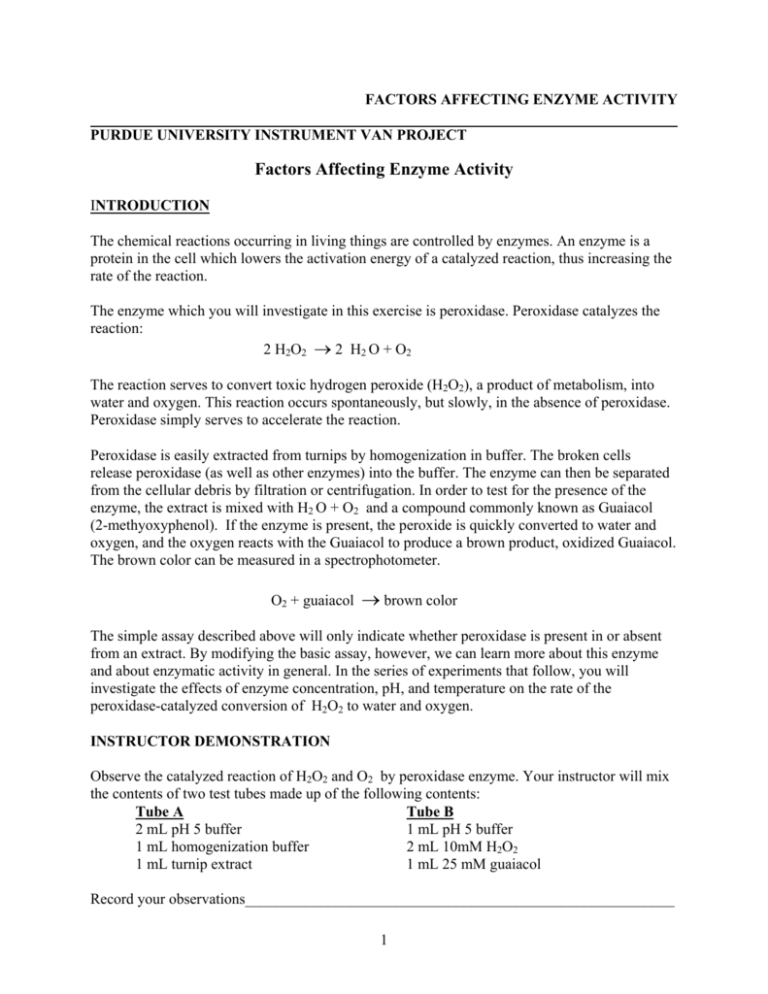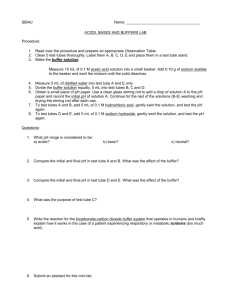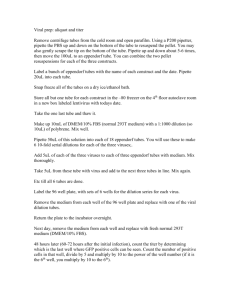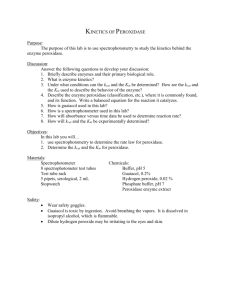Factors Affecting Enzyme Activity
advertisement

FACTORS AFFECTING ENZYME ACTIVITY PURDUE UNIVERSITY INSTRUMENT VAN PROJECT Factors Affecting Enzyme Activity INTRODUCTION The chemical reactions occurring in living things are controlled by enzymes. An enzyme is a protein in the cell which lowers the activation energy of a catalyzed reaction, thus increasing the rate of the reaction. The enzyme which you will investigate in this exercise is peroxidase. Peroxidase catalyzes the reaction: 2 H2O2 → 2 H2 O + O2 The reaction serves to convert toxic hydrogen peroxide (H2O2), a product of metabolism, into water and oxygen. This reaction occurs spontaneously, but slowly, in the absence of peroxidase. Peroxidase simply serves to accelerate the reaction. Peroxidase is easily extracted from turnips by homogenization in buffer. The broken cells release peroxidase (as well as other enzymes) into the buffer. The enzyme can then be separated from the cellular debris by filtration or centrifugation. In order to test for the presence of the enzyme, the extract is mixed with H2 O + O2 and a compound commonly known as Guaiacol (2-methyoxyphenol). If the enzyme is present, the peroxide is quickly converted to water and oxygen, and the oxygen reacts with the Guaiacol to produce a brown product, oxidized Guaiacol. The brown color can be measured in a spectrophotometer. O2 + guaiacol → brown color The simple assay described above will only indicate whether peroxidase is present in or absent from an extract. By modifying the basic assay, however, we can learn more about this enzyme and about enzymatic activity in general. In the series of experiments that follow, you will investigate the effects of enzyme concentration, pH, and temperature on the rate of the peroxidase-catalyzed conversion of H2O2 to water and oxygen. INSTRUCTOR DEMONSTRATION Observe the catalyzed reaction of H2O2 and O2 by peroxidase enzyme. Your instructor will mix the contents of two test tubes made up of the following contents: Tube A Tube B 2 mL pH 5 buffer 1 mL pH 5 buffer 1 mL homogenization buffer 2 mL 10mM H2O2 1 mL turnip extract 1 mL 25 mM guaiacol Record your observations_________________________________________________________ 1 FACTORS AFFECTING ENZYME ACTIVITY PURDUE UNIVERSITY INSTRUMENT VAN PROJECT ______________________________________________________________________________ PURPOSE You will use the demonstrated reaction to study the effect of four factors on the reaction rate of peroxidase on hydrogen peroxide. The factors are: #1 concentration #2 pH #3 temperature #4 boiling MATERIALS Spectrophotometer (digital) test tube racks wash bottle Kimwipes Solutions and reagents as per procedure sections cuvette tubes (12) 10 mL pipette and filler beakers marker SAFETY CONSIDERATIONS Goggles and aprons must be worn at all time during the lab. EFFECT OF ENZYME CONCENTRATION ON THE REACTION RATE In this experiment you will set up 7 test tubes. The first tube labeled (0) will be the control. All of the ingredients needed for the reaction, except the turnip extract containing enzyme will be placed in this tube. It will be referred to as the "blank" in the procedure. Tubes #1 and #2, when mixed, will contain exactly the same ingredients as the blank plus a small amount of turnip extract which should contain the peroxidase enzyme. Similarly, tubes #3 and #4 and tubes #5 and #6 will be identical to tube #1 and #2, except for the presence of higher concentrations of the extract (peroxidase). No brown pigment will be produced in the blank, which is intended to serve as the control for the standardization of the spectrophotometer. The rate of pigment production in mixed tubes #1+#2, #3+#4, and #5+#6 will be measured to determine whether the rate is a function of enzyme concentration. PROCEDURE 1. Turn on the Spectrophotometer to let it warm up about 5 minutes. Label 7 test tubes: #0 - #6. Set the wavelength at 500 nm. 2. Prepare a control test tube (called the "blank"), containing all of the ingredients of the Tube #0 (blank or control) 2 mL homogenization buffer 2 experiment exc FACTORS AFFECTING ENZYME ACTIVITY PURDUE UNIVERSITY INSTRUMENT VAN PROJECT 3 mL pH 5 buffer 2 mL 10 mM H2O2 1 mL 25 mM guaiacol 3. Prepare three tubes marked #1, #3, and #5 with the following solutions. 1 mL pH 5 buffer 2 mL 10 mM H2O2 1 mL 25 mM guaiacol 4. Prepare three other tubes as follows a. Marked tube #2 2 mL pH 5 buffer 1.5 mL homogenization buffer 0.5 mL turnip extract b. Marked tube #4 2 mL pH 5 buffer 1 mL homogenization buffer 1 mL turnip extract c. Marked tube #6 2 mL pH 5 buffer 2 mL turnip extract 5. Set the 100% transmission by using Tube #0 as the blank (control). The spectrophotome 6. Using a Kimwipe, clean the blank cuvette (Tube #0) and then place the cuvette in the sample cham 7. Remove the cuvette from the sample chamber and set aside for use later. The spectrophotometer is now calibrated. 8. You are now ready to run three trials for which will measure the effect of enzyme concentration During each trial you will mix the contents of two tubes including the enzyme and the will need a clock with a second hand to make your readings. The test tubes must be prepared first and be ready for the trials to be run. Tube preparation was described in procedure 3 and 4. peroxide and al The mixing procedure of the prepared trial tubes is as follows. Add the contents of tube #1 to tube #2, then pour the contents of this tube back into tube #1. This tube is 3 FACTORS AFFECTING ENZYME ACTIVITY PURDUE UNIVERSITY INSTRUMENT VAN PROJECT This must be done quickly. The time should begin when the contents of the first tube are placed into the other tube. Make su a. To run the first trial prepare to mix tube #1 with tube #2. Mark the time. This mixture will then be pla and the readings made. Record the readings in the table below. At the end of the reading time, remove th b. Run the next trial by mixing tube #3 with tube #4 in the same way as the previous trial. c. Run the next trial by mixing tube #5 with tube #7 in the same way as the previous trial. Record all % tr 9. After the trials are over, flush the contents of all test tubes down the sink and rinse the test tubes with DATA TABLE I Time Tubes mL extract 20" 40" 60" 80" 100" 120" ____________________________________________________________ #1 + #2 0.5 ____ ____ ____ ____ ____ _____ #3 + #4 1.0 ____ ____ ____ ____ ____ _____ #5 + #6 2.0 ____ ____ ____ ____ ____ _____ ____________________________________________________________ 10. Graph Your Results a) Make the graph by plotting Time (seconds) on the horizontal axis and Transmittance (%) on the vertical axis. b) Title the graph (include your initials for identification), label and scale the axis properly, include point protectors and a line connecting the plot points. Be sure to properly label each data series on the graph for proper identification. 4 FACTORS AFFECTING ENZYME ACTIVITY PURDUE UNIVERSITY INSTRUMENT VAN PROJECT QUESTIONS 1. In what way is the rate of the reaction dependent on the concentration of the enzyme? 2. What would you expect the trend to be for 3.0 mL of extract to be used in one of the trials? EFFECT OF pH ON THE ENZYME-CATALYZED REACTION In the previous experiment, the conditions in the control and mixed tubes were identical except for the concentration of the enzyme. In this experiment, the reaction tubes will have identical enzyme and substrate concentrations, temperature, etc., but the pH will vary from one reaction tube to another, allowing you to determine the optimal pH range for the peroxidase-catalyzed reaction. PROCEDURE 1. Turn on the spectrophotometer to let it warm up for about 5 minutes. 2. Prepare a control test tube (called a "blank") for standardizing the instrument by the following procedure. Label a test tube 0 and then pipette the following Test Tube #0 1 mL homogenization buffer 4 mL pH 5 buffer 2 mL 10 mM H2O2 1mL 25 mM guaiacol 3. Label tubes #1 through #8 4. Pipette the following solutions into tubes #1, #3, #5, and #7: 2 mL 10 mM H2O2 1 mL 25 mM guaiacol 5. Prepare the remaining tube as follows: a. Into marked tube #2 pipette the following solutions 4 mL pH 3 buffer 1 mL turnip extract. b. Into marked tube # 4 pipette the following solutions 4 mL pH 5 buffer 1 mL turnip extract 5 solutions into th FACTORS AFFECTING ENZYME ACTIVITY PURDUE UNIVERSITY INSTRUMENT VAN PROJECT c. Into marked tube #6 pipette the following solutions 4 mL pH 7 buffer 1 mL turnip extract d. Into marked tube #8 pipette the following solutions 4 mL pH 9 buffer 1 mL turnip extract 6. Set the 100% transmission by using tube #0 as the blank. The spectrophotometer must be calibrated ac 7. Using the mixing procedure described in the previous lab procedure (procedure 9), 120 seconds and record the data. Remove the tube from the sample chamber after the last reading and flush the contents down the drain. Rinse the tube with distilled water. quickly mix the 8. 9. Repeat step 5 and 6 using tubes #3 and #4. 10. Record the data. Repeat step 7 and 8 using tubes #5 and #6. 11. Record the data. Repeat step 7 and 8 using tubes #8 and #9. Record all data in the data Table II. DATA TABLE II Time Tubes pH 20" 40" 60" 80" 100" 120" ________________________________________________________ #1 + #2 3 _____ _____ _____ _____ _____ _____ #3 + #4 5 _____ _____ _____ _____ _____ _____ #5 + #6 7 _____ _____ _____ _____ _____ _____ #7 + #8 9 _____ _____ _____ _____ _____ _____ ________________________________________________________ 12. Graph your results. a) Make the graph by plotting Time (seconds) on the horizontal axis and Transmittance (%) on the vertical axis. b) Title the graph (include your initials for identification), label and scale the axis properly, include point protectors and a line connecting the plot points. Be sure to properly label each data series on the graph for proper identification. 6 FACTORS AFFECTING ENZYME ACTIVITY PURDUE UNIVERSITY INSTRUMENT VAN PROJECT QUESTIONS 1. How does the activity of the enzyme vary with pH? 2. What is the pH at which the greatest peroxidase activity occurs? 3. Do you think all enzymes would work well at the pH found in this experiment? Explain your answer. EFFECT OF TEMPERATURE ON THE ENZYME-CATALYZED REACTION The enzyme and substrate concentrations, and pH will be identical in the following series of mixtures, but the reactions will be performed at different temperatures in order to determine the temperature range which will produce the greatest peroxidase activity. PROCEDURE 1. Turn on the spectrophotometer to let it warm up for about 5 minutes. Set wavelength at 2. Prepare a control test tube (called a "blank") for standardizing the instrument. Label a test tube #0 and then pipette the following solutions into the tube and set it aside for use later. Th Test Tube #0 2 mL homogenization buffer 3 mL pH 5 buffer 2 mL 10 mM H2O2 1mL 25 mM guaiacol 3. Label tubes #1 through #8 4. Pipette the following solutions into tubes #1, #3, #5, and #7. 2 mL 10 mM H2O2 1 mL 25 mM guaiacol 5. Pipette the following solutions into marked tubes #2, #4, #6, and #8. 4 mL pH 5 buffer 1 mL turnip extract 6. Prepare hot water baths using 800 mL beakers placed on hot plates. Place enough water in each water b 20°C: #1 and #2 30°C: #3 and #4 40°C: #5 and #6 50°C: #7 and #8 7 500 nm. FACTORS AFFECTING ENZYME ACTIVITY PURDUE UNIVERSITY INSTRUMENT VAN PROJECT Place the tubes in the water baths for 10 minutes prior to testing. Do not overheat the 7. tubes. They sho Set the 100% transmission by using tube #0 as the “blank”. The spectrophotometer must be calibrated ac 8. Remove tubes #1 and #2 from the 20°C water bath and wipe the fluid from the outside of the tubes. Note period remove the tube, flush the contents down the drain, and rinse the tubes with distilled water. 9. Repeat step 8 using tubes #3 and #4. 10. Repeat step 8 using tubes #5 and #6. 11. Repeat step 8 using tubes #7 and #8. Record all readings in Data Table III. DATA TABLE I I I Time Tubes Temp (°C) 20" 40" 60" 80" 100" 120" ______________________________________________________________ #1 + #2 20° _____ _____ _____ _____ _____ _____ #3 + #4 30° _____ _____ _____ _____ _____ _____ #5 + #6 40° _____ _____ _____ _____ _____ _____ #7 + #8 50° _____ _____ _____ _____ _____ _____ ______________________________________________________________ 12. Graph your results. a) Make the graph by plotting Time (seconds) on the horizontal axis Transmittance (%) on the vertical axis. b) Title the graph (include your initials for identification), label and scale the axis properly, include point protectors and a line connecting the plot points. Be sure to properly label each data series on the graph for proper identification. QUESTIONS 8 FACTORS AFFECTING ENZYME ACTIVITY PURDUE UNIVERSITY INSTRUMENT VAN PROJECT 1. In what way does the activity of the enzyme vary with temperature? 2. At what temperature does the peroxidase appear to have the greatest effect in oxidizing 3. What would be a plausible reason if no peroxidase activity were to occur at a particular temperature. the peroxide? EFFECTS OF BOILING ON ENZYME ACTIVITY Extreme temperatures causes the native folded structure of proteins to uncoil into random configuration. As a result, the protein loses its biological enzymatic activity. This "denaturization" of a protein and the consequent loss of activity will be demonstrated using the peroxidase reaction. PROCEDURE 1. Turn on the spectrophotometer to let it warm up about 5 minutes. 2. Set up a control test tube (the "blank") for standardizing instrument by labeling a test Test tube #0 1 mL homogenization buffer 4 mL pH 5 buffer 2 mL 10 mM H2O2 1 mL 25 mM guaiacol 3. Label tubes #1 through #4. 4. Pipette the following solutions into tubes marked #1 and #3. 2 mL 10 mM H2O2 1 mL 25 mM guaiacol 5. Pipette the following solutions into tubes marked #2 and #4. 4 mL pH 5 buffer 1 ml turnip extract 6. 7. Place tube #4 in a boiling water bath for 10 minutes, then transfer it to a beaker of water at room tempe Set the 100% transmission on the spectrophotometer by using tube #0 as the "blank" . The spectropho 8. Noting the time, quickly mix the contents of tube #1 and #2. Insert the cuvette into the 9. Repeat step 8 using tubes #3 and #4. DATA TABLE IV 9 tube #0. Pipet sample chambe FACTORS AFFECTING ENZYME ACTIVITY PURDUE UNIVERSITY INSTRUMENT VAN PROJECT Time Tubes Boiled? 20" 40" 60" 80" 100" 120" ____________________________________________________________ #1 + #2 No _____ _____ _____ _____ _____ _____ #3 + #4 Yes _____ _____ _____ _____ _____ _____ _____________________________________________________________ 10. Prepare a graph of your data. a) Make the graph by plotting Time (seconds) on the horizontal axis and Transmittance (%) on the vertical axis. b) Title the graph (include your initials for identification), label and scale the axis properly, include point protectors and a line connecting the plot points. Be sure to QUESTIONS 1. How does boiling affect the activity of peroxidase? 2. Develop a procedure to optimize the catalysis of hydrogen peroxide. 3. An enzyme found in human blood would be expected to have a pH optimum of: (a) 6.2, (b) 7.4, (c) 8.6, (d) 7.0 4. The enzyme pepsin, which digests proteins in the stomach, would be expected to have a pH optimum of: (a) 2.0, (b) 5.0, (d) 7.0 5. Why was the turnip extract kept on ice during the lab session? TEACHERS GUIDE TO: ENZYME ACTIVITY FACTORS AFFECTING ENZYME TYPICAL CLASSROOM USE. Recommended use of this lab for Gifted First year Biology, Advanced Biology and Chemistry (first year) STRATEGY FOR CONDUCTING LAB 1. Have students work in groups of 3 or 4. 2. Assign each group only one factor to investigate in the lab. a. Only one group need do the "Boiled" enzyme section. b. Duplicate groups for temperature could be assigned temperatures of 25°, 35°, 45°, and 55°. c. Duplicate groups for concentration could include 1.5, 2.5, and 3.0 mL of extract. *Remember to reduce the amount of buffer to maintain the 4 mL total liquid 10 properly la FACTORS AFFECTING ENZYME ACTIVITY PURDUE UNIVERSITY INSTRUMENT VAN PROJECT volume in the even numbered trial test tubes. d. Duplicate groups for pH could use different pH buffers depending on availability (maintain r CURRICULUM INTEGRATION This lab would be included in a biology unit on biochemistry. Typically this would include sections of study on carbohydrates, fats, nucleotides, and proteins. The identification of sugars, starch, oils, and proteins would be a suitable experiment to do prior to this lab. ASSESSMENT 1. Submission of group report including completed graphs and summary report, using 2. Inclusion of V-diagram with lab report. 3. Inclusion of concept map in lab report. 4. Groups prepare report using multimedia format. presentation for PREPARATION MATERIALS spectrophotometer cuvette tubes (12/group) test tube racks (4-8) pipet (4 10mL/group) & pipette fillers (1-2/group) beakers for water bath (12/class) wash bottle for distilled water (1/group) marker (1/group) & Kimwipes (1 box/group) SOLUTIONS/CONSUMABLES Turnip Extract Preparation Blend 2 grams fresh turnip for 20 seconds at low speed in 300 mL 0.1 M sodium phosphate buffer, pH 7. Filter the homogenate through a Kimwipe and keep on ice for the remainder of the lab session. It would be advisable to test the extract, as in the concentration procedure (tube #5+#6), to verify the reliability of the extract. Note: Not all turnips are created equal. Other Supplies: pH 3 buffer pH 5 buffer pH 7 buffer pH 9 buffer homogenization buffer (0.1 M sodium phosphate, pH 7) 10 mM H2O2 (Prepare Fresh. Measure 3.7 mL of 3% stock H2O2 into a volumetric flask. Dilute to a final volume of 500 mL with distilled water.) 25 mM Guaiacol. (Prepare Fresh. Dilute 0.7 mL of guaiacol with isopropyl alcohol to a final volume o 11 FACTORS AFFECTING ENZYME ACTIVITY PURDUE UNIVERSITY INSTRUMENT VAN PROJECT SAFETY AND DISPOSAL All chemical materials can be flushed down the drain with water. VARIATIONS Change the length of time for measuring enzyme activity. This lab could be used in conjunction with or in addition to Determination of the Order of Reaction of an Enzyme Catalyzed Reaction REFERENCES Bowen, W.R. and Baxter, W.D., Experimental Cell Biology, An Integrated Laboratory Guide and Text, Macmillan Publishing Co, Inc., New York, 1980 INDIANA STATE PROFICIENCIES #2,#3,#4,#5(a,c,d,e,f),#6(a,b,c),#7 Prepared by: Franklin Bynum (Phone: 317-898-6133 ext. 236) Warren Central High School 9500 E. 16th St. Indianapolis, IN 46229 12 FACTORS AFFECTING ENZYME ACTIVITY PURDUE UNIVERSITY INSTRUMENT VAN PROJECT Advanced Workshop 599C 4 hours July 8 to 18, 1996 13






